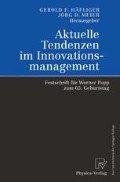Zusammenfassung
In Unternehmensrechnung und Controlling dominieren finanzielle und materielle Potentiale. Die Abbildung finanzieller Potentiale und Aktivitäten durch das Rechnungswesen im financial accounting, aber auch im management accounting hat lange Tradition. Immaterielle Potentiale und Werte werden zwar beispielsweise in der Bilanz erfasst, doch ist das Controlling solcher Grössen, wenn es um deren Messung, Bewertung und optimale Allokation geht, in Schrifttum und Praxis ver-gleichsweise unterentwickelt. In diesem Beitrag wird aufgezeigt, wie man solche Potentiale in Ratioskalen messen und bewerten kann. Ferner wird gezeigt, dass auch ein Controlling im Sinne einer optimalen Koordination bzw. Allokation möglich ist.1
Access this chapter
Tax calculation will be finalised at checkout
Purchases are for personal use only
Preview
Unable to display preview. Download preview PDF.
Literatur
Hall, R. (1992): The Strategic Analysis of Intangible Resources. In: Strategic Management Journal, Vol. 13 (1992). S. 135–144.
Hall, R. (1993): A Framework Linking Intangible Resources and Capabilities to Sustainable Competitive Advantage. In: Strategic Management Journal, Vol. 14 (1993). S. 607–618.
Kühn, R./ Grünig, R. (1998): Grundlagen der strategischen Planung. Bern/Stuttgart/Wien 1998.
Saaty, Th. L. (1980): The Analytic Hierarchy Process. Planning, Priority Setting, Resource Allocation. Pittsburgh 1980.
Saaty, Th. L. (1996): The Analytic Network Process. Pittsburgh 1996.
Saaty Th. L./ Vargas, L. G. (1999): The Allocation of Intangible Ressources: The Analytic Hierarchy Process and Linear Programming. Abstract-Paper. Pittsburgh 1999.
Saaty, Th. L./ Vargas, L. G./ Dellmann, K. (1999): The Allocation of Intangible Resources: The Analytic Hierarchy Process and Linear Programming. 1999 (Publikation eingereicht).
Editor information
Editors and Affiliations
Rights and permissions
Copyright information
© 2000 Springer-Verlag Berlin Heidelberg
About this chapter
Cite this chapter
Dellmann, K. (2000). Controlling immaterieller Potentiale: Messung, Bewertung und optimale Allokation. In: Häfliger, G.E., Meier, J.D. (eds) Aktuelle Tendenzen im Innovationsmanagement. Physica, Heidelberg. https://doi.org/10.1007/978-3-642-57657-7_18
Download citation
DOI: https://doi.org/10.1007/978-3-642-57657-7_18
Publisher Name: Physica, Heidelberg
Print ISBN: 978-3-642-63325-6
Online ISBN: 978-3-642-57657-7
eBook Packages: Springer Book Archive

